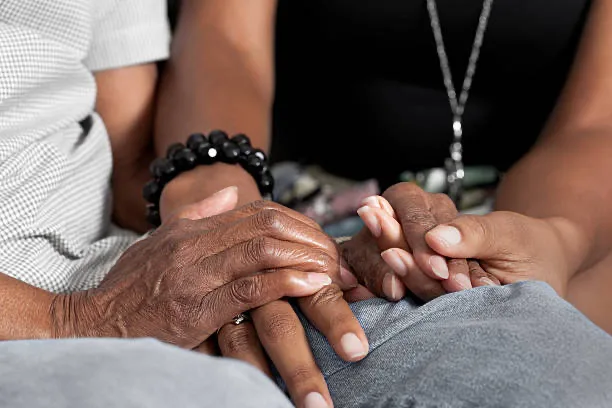10 Disheartening Reasons I Knew My Mother Needed To Start Hospi…

10 disheartening reasons I knew my mother needed to start hospice care immediately
“I’m sorry. Given your results, without chemo treatments you have less than 6 months to live.” stated the doctor as he lowered his head and slowly backed away from my mother’s bedside, leaving to the door of her room. We were both overrun with tons of emotions that ranged from confusion to denial, to anger.
She became ill quickly. Even though she had shown signs of sickness for the entire previous month, it still caught both of us by surprise. It can be extremely scary for a person and their loved ones when they don’t know exactly what to do next. My mother by this time, was showing clear signs she would require hospice, a level of care that I knew nothing about. I wasn’t yet a nurse and unknowingly to me, I wouldn’t become one for another 7 years.
When a person is in a similar situation as this, they may have a couple of options from which they can choose: hospice or palliative care. So, what exactly is hospice? What exactly is palliative care? Palliative care is a specific type of care given to patients that may choose to have treatments. These may be ongoing and intended to relieve any chronic medical conditions. Palliative care is still treating the disease process. With palliative care, comfort is a priority. So, then what exactly is hospice care? Hospice care provides a level of comfort for those who have decided not to treat their disease process. Hospice does not include any treatments that would be considered life-saving measures. Examples of these can be but are not limited to surgery, chemotherapy, dialysis, or other types of aggressive treatments. It is under hospice care they assist patients with “transitioning” into the end-of-life cycle.
Like most people, I did not know what to expect, or what was coming next. I was scared out of my mind. As her symptoms grew more severe, my feelings of helplessness increased. Sure, we had family and friends. Although much like me, everyone felt just as lost. Some even pulled away fearing that it may become too much of a responsibility to take on. Others rarely knew what to say.
On top of everything else, there were so many other worries. You may have asked, “How are the bills going to get paid? How are home repairs that are needed going to be taken care of? What about the hospital bills? Do they have a life insurance policy in place? Are there still minor children that need to be looked after? What about them?” My mother didn’t have an insurance policy. Initially, she did, but it was through her employer. This would be tied to a job that she could no longer physically do. Does any of this sound like what you are going through?
If you are reading this right now and you find you are in a similar situation, let me offer you some much-needed words of comfort; you are not alone. Knowing now what I didn’t know back then, has placed me in a position to help others by giving some kind words and guidance. Another thing that I can tell you is that you absolutely, positively, do not need to become a nurse or other healthcare professional to make sure your person gets the proper care that they need. Thankfully, this is a battle that no one has to endure by themselves. There are many resources available today that can direct you to the proper care. Lenity Light Hospice of Texas is a caring group of compassionate individuals ready to take you by the hand and walk with you through the emotional storms. Staffed with doctors, counselors, nurses, chaplains, social workers, nursing aides, volunteers, office staff and others, Lenity Light Hospice of Texas will provide the care you and your family need during these times of uncertainty.
Another way you can endure what may, or may not take place, is to arm yourself with as much information as possible. Since I have gone through those periods of struggle, hopefully, you don’t have to. Here is a chance for you to learn from my experience. There was no more denial. My mother was told by the doctors that even chemo would not save her life but only prolong it. With that, she declined any other treatment options. Hospice proved to be the best solution for my mother as she would only require comfort measures at this point. So, let’s talk about it. As time quickly went on, her condition advanced. This is when I saw the 10 disheartening reasons I knew my mother needed to start hospice care immediately.
Increased Pain Levels. Some patients that have a terminal illness, or a sickness that will cause death, may experience high levels of pain and discomfort. With most diseases, some pain is to be expected. However, a person’s pain level can be so awful that it affects their quality of life. There may be pain medications that have been previously prescribed that are no longer working. A few ways we can recognize this might be an elevation in blood pressure, or heart rate. Another potential sign of increased pain might be changing in facial expressions, like squeezing eyelids closed (squinting) or clenching teeth tightly. The most obvious signs are crying, yelling, or moaning. Depending on a person’s mental and physical abilities, they may not say they are in pain. If this occurs, and it’s added to other factors on this list, it may be time to consider hospice.
Difficulty breathing. We may describe this as shortness of breath. The medical term for this is called tachypnea. This is when a person breathes rapidly or wheezes as if they just ran a mile. A person may have slow, loud-sounding breaths, it may look similar to someone having an asthma attack. The medical term for this is dyspnea. This type of breathing difficulty can cause discomfort to the patient, as well as anxiety for family members and onlookers. Under hospice care, certain medications may be given to relax the muscles in the lungs to prevent the patient from struggling to breathe. We may also pair this with pain medications as difficulty breathing can be extremely uncomfortable.
Making future plans. This may be confusing to some. A person who knows they are nearing the end of life is not concerned with accomplishing goals and achievements, but making other plans or arrangements. This can regard any estate planning, finalization of their will, declaring a Power Of Attorney, and several other legal matters. These patients want to make sure the loved ones they leave behind are cared for emotionally and financially.
Nausea and vomiting. Certain diseases, like most types of cancer, will cause some type of nausea and vomiting. Dependent on where in the body the disease process is focused, it may cause these symptoms to flare up worse. Many medications under normal circumstances have common side effects such as nausea and stomach upset. It’s possible that certain illnesses may never be relieved in some hospice patients. This brings us to the next point.
Decrease in food and drink, or refusal to eat. Trying to eat may be a painful experience for some hospice patients. Once again, depending on what part of the body might be affected, eating may actually worsen the condition. If the patient is having severe nausea symptoms, the desire to eat will diminish quickly. This can cause the next problem on the list.
Major weight loss. Most of us when sick may lose a few pounds. For example, typical flu-like symptoms may cause vomiting and dehydration. A person may not be up to having a full-course dinner while battling the cold or flu. However, some hospice patients with end-stage illnesses may have no desire to eat at all. The level of pain they may experience may interfere with their appetite. Another consideration is that they might have a measure of depression. Intense waves of sadness may cause a person to have an extremely low, to non-existent appetite.
Hallucinations, visions, or confusion. Now it is very common for hospice patients to be on pain or anti-anxiety medications that are very strong. Usually, these medications are given in high dosages or shorter time intervals. This allows the hospice patient to remain comfortable. When less oxygen is being sent to the brain because of the organs beginning to fail, this may cause the hospice patient to become disoriented or confused. Some drugs may have side effects that cause them to see something that is not really there. Another possibility for this could have to do with spirituality. Many people nearing death have mentioned seeing long-lost relatives, spouses, and even pets that have since passed away. Some hospice patients may have flashbacks to certain time frames in their lives when they had their greatest memories.
A drastic change in body temperature. The hospice patient may feel very cool and clammy, or extremely hot. With less blood circulating to the section of the brain that controls a person’s temperature, it may not be regulated within the body properly. The hospice patient’s skin may also display other telling signs such as blue or purple spots and streaks under the surface of the skin. We know the medical term for this condition as mottling. This shows that the blood under the skin has a minimal amount of oxygen in it.
Loss of bowel and bladder functions. As organs slow their function, the stomach and kidneys will not function at their normal levels. The person may not have the ability to contract the muscles and hold bodily fluids long enough to get to the restroom. Pain medications such as narcotics may cause constipation as well. This coupled with the lack of walking about, may keep the digestive system from working properly. Keep in mind, the hospice patient may have a major decrease in fluids and food intake. Sometimes, the ability to swallow food is lost completely, leaving them with little to no output from either bodily system.
Becoming socially withdrawn and less responsive. As their condition worsens, they may become more quiet. This could be from a host of reasons such as drowsiness caused by medications, or lack of oxygen to the brain making it harder for them to think clearly or understand what is happening around them. This can also be an emotional issue with depression beginning to set in. We have noted that some individuals purposely withdraw from their loved ones because they believe it will make the grief caused by their death somehow easier to tolerate and manage. People may experience an entire range of emotions. During this time, continue to show them emotional support. This may involve sitting quietly with them, perhaps having a one-sided conversation about pleasant memories, or some other act to let them know you are there for them.
So How Do You Prepare For These Changes?
Like this project
Posted May 21, 2023
10 disheartening reasons I knew my mother needed to start hospice care immediately “I’m sorry. Given your results, without chemo treatments you have less than …
Likes
0
Views
0




